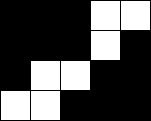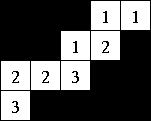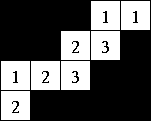PROBLEM OF THE MONTH
February 2004
A Littlewood-Richardson crossword puzzle is a rectangular
grid of black and white squares. The "clues" to the puzzle are a set of
positive integers. The objective is to fill the white squares with
these numbers in such a way that the following three conditions are
satisfied:
- On each row, every number is greater than or equal to each number to
the left of it.
- In each column, every number is strictly greater than each number above
it.
- As you read off the numbers in the grid from right to left
and from top to bottom, the number of "1"s read is always at least as large
as the number of "2"s, which is always at least as large at the number of "3"s,
which is at least as large as ... and so on.
For example, given the following Littlewood-Richardson puzzle,

| "Clues":
1,1,1,
2,2,2,
3,3
|
consider the following two arrangements:
The arrangement on the left is a solution to the puzzle. The arrangement
on the right satisfies the first two conditions, but not the third. Notice
that as you read from the top right corner to the rightmost square on the
third row, you have encountered two "3"s, but only one "2".
PROBLEM:
- Find a second solution to the Littlewood-Richardson crossword puzzle
given above. Prove that there are only two solutions.
- How many distinct solutions are there to the following
Littlewood-Richardson crossword puzzle:

| "Clues":
1,1,1,1,
2,2,
3
|
- If you use the same grid as in the previous question, what other
sets of clues have at least one solution? (Hint: There are nine of them,
four of which have a unique solution and five of which have multiple
solutions.)
Submit your solution to the Mathematics Undergraduate Office (Math P-142)
or electronically to Prof. Kudzin at
problem@math.sunysb.edu
by the due date. Acceptable electronic formats are: PDF, Postscript, DVI,
(La)TeX, or just plain text. Please include your name and phone number,
or preferably your email address.
Closing date: March 1st at 12 pm.




